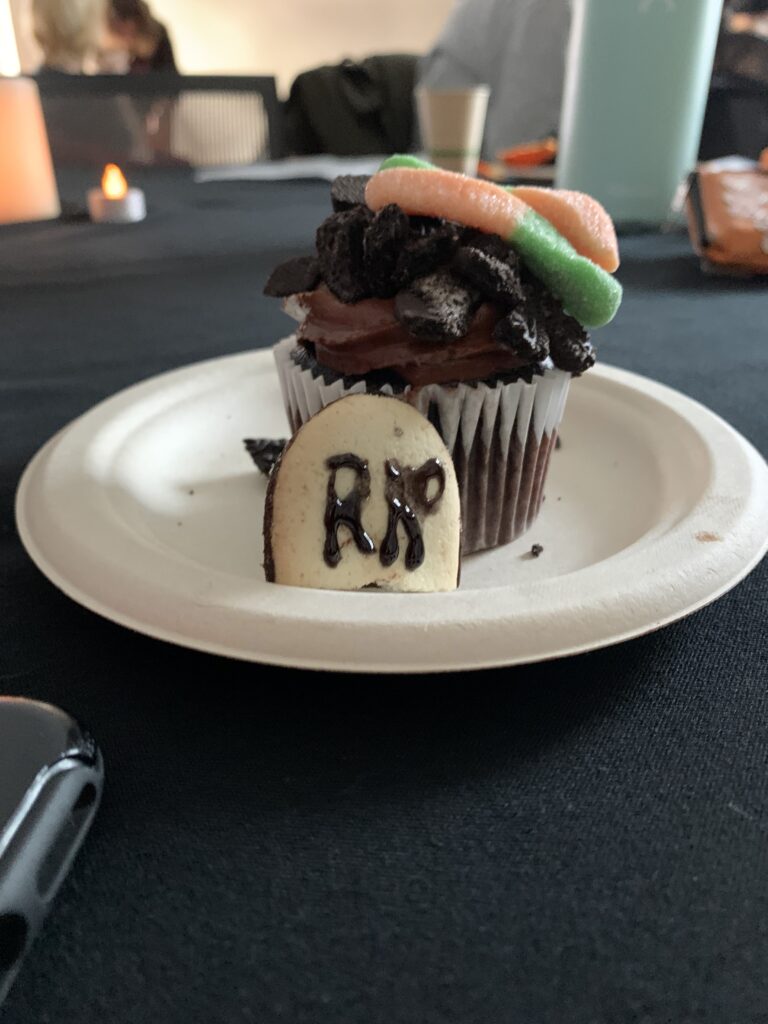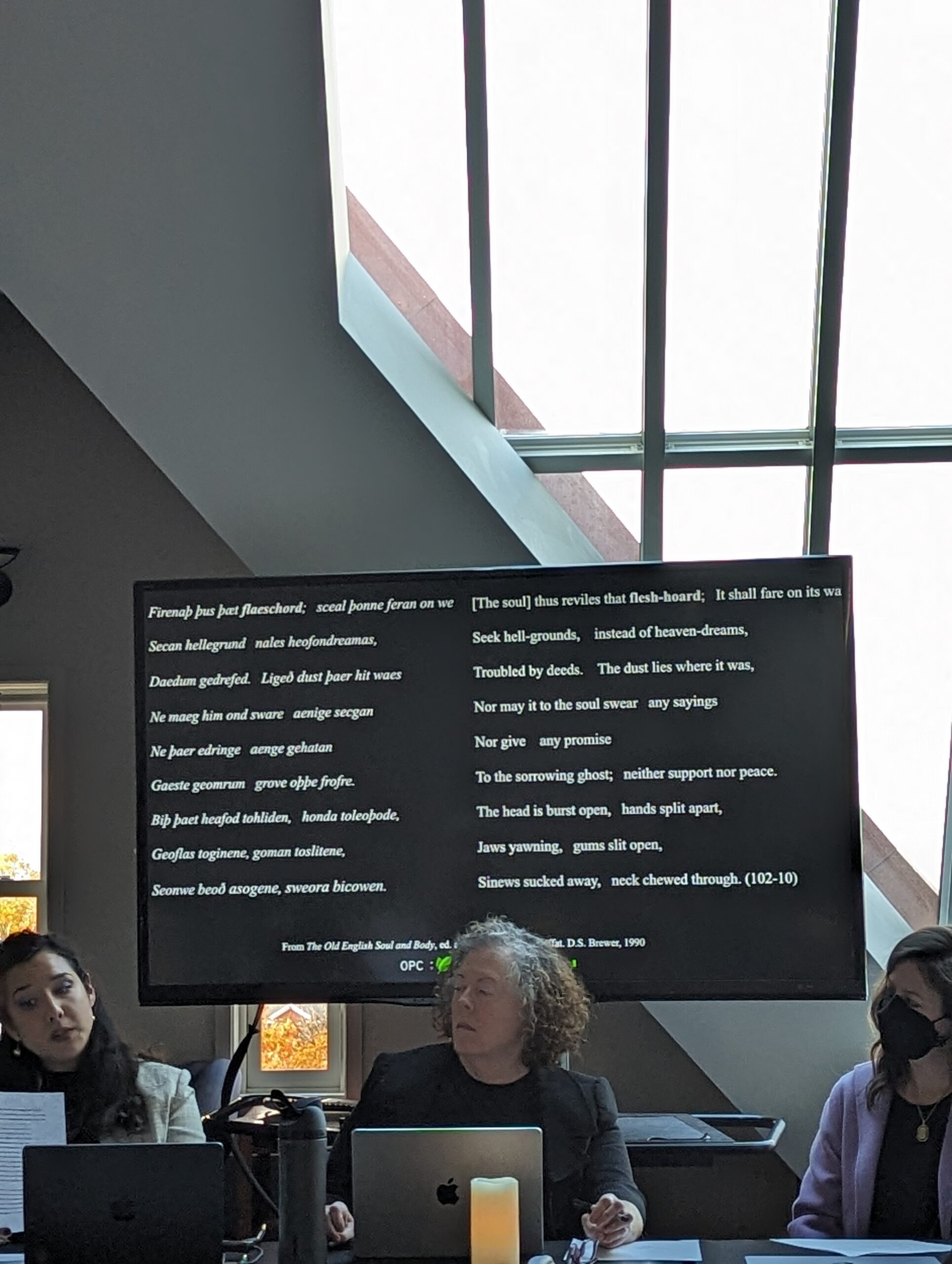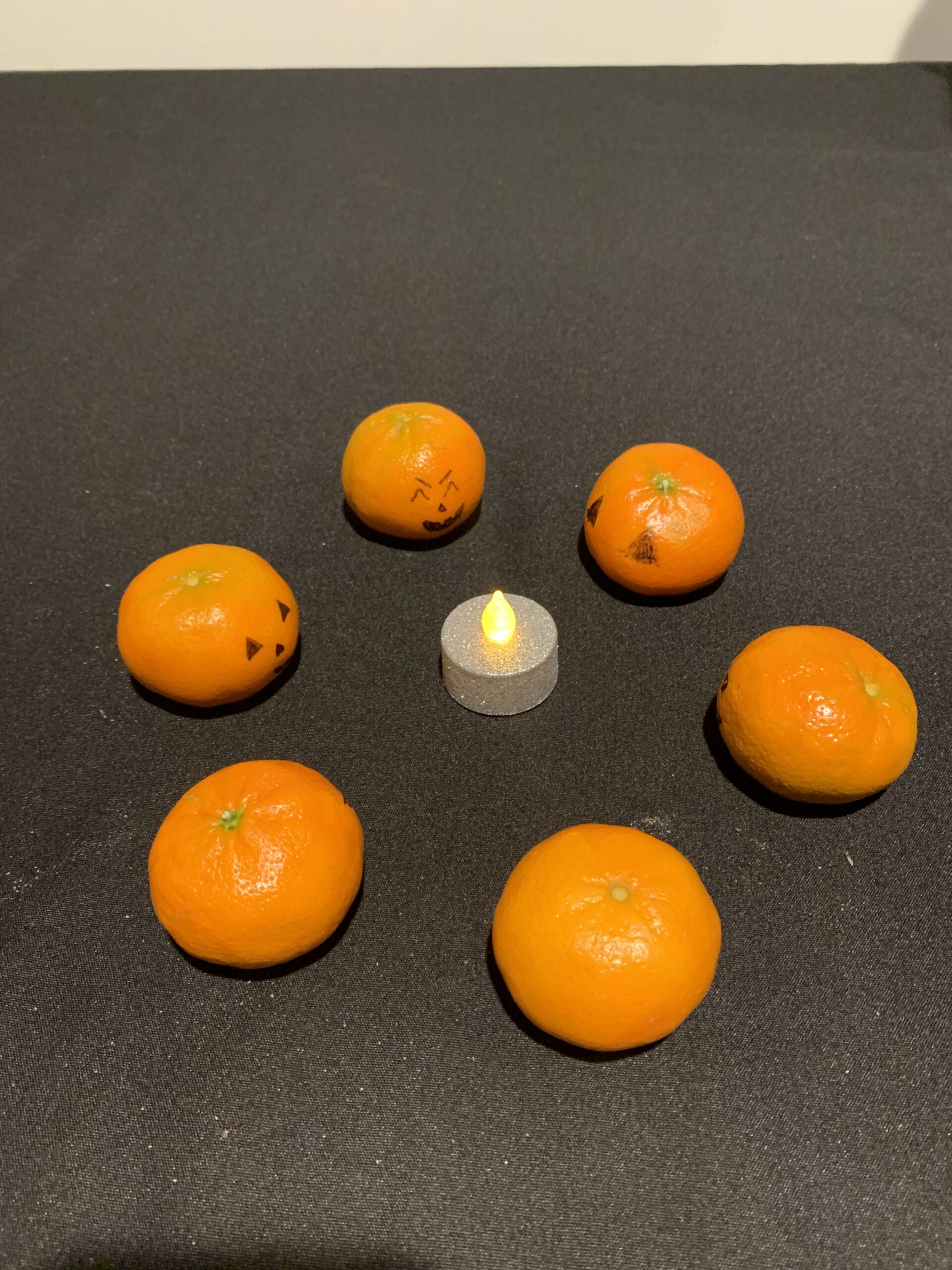A Fearful Double Feature: Literary Salon Death Panel and Haunted Coffee House
Contact
The Words: Macalester's English Student NewsletterSenior Newsletter Editors:
Birdie Keller '25
Callisto Martinez '26
Jizelle Villegas '26
Associate Newsletter Editors:
Ahlaam Abdulwali '25
Sarah Tachau '27
by Zoë Roos Scheuerman ’24
Alongside the English department’s traditional Haunted Coffee House, the new and evolving Literary Salon format offered a fresh opportunity to give students and faculty alike the jeepers-creepers. As the “Panel” name suggests, the literary salon took on a conference-panel like format, plus glowing LED candles, black tablecloths, and graveyard-themed cupcakes. After a quick Haunted Coffee House where students settled in with the aforementioned cupcakes and Jack-o-lantern clementines, the panel got underway!

Professors Daylanne English, Coral Lumbley, and Amy Elkins explored the theme of death from three different avenues. Dr. Lumbley kicked off the panel by invoking the thin line between life and death during autumn, when the leaves are at their most vibrant before dying. She then used this reminder that death is a part of life to transition into a paper on death in medieval Europe, explaining beautiful, illuminated manuscripts with eerie parables, showing opulent Catholic relics and funeral effigies, and even reading some macabre poems aloud in old English!
Dr. Lumbley noted that, during a time of high mortality, death in medieval Europe was ever-present and, for nobles, a great equalizer: no matter how much wealth they had in life, their skeleton won’t be made of gold. One tale which they recounted was that of three nobles who travel into the woods on horseback, only to encounter themselves as corpses in various stages of decomposition: a morbid, but poignant, memento mori. Dr. Lumbley additionally explored how spine-chilling ghost stories from medieval England function as reactions to, and histories of, colonialism. When Anglo-Saxon settlers pushed indigenous Britons out of much of modern England and into modern Wales, vengeful Briton kings became discontented spirits roving their dispossessed lands.

As students sipped on pumpkin-spice flavored Nespresso lattes (This isn’t sponsored… unless Nespresso wants it to be?), the panel switched gears. Dr. English began an exploration of spiritualism in the Black community during the 1800s and the Harlem Renaissance. She began with some background on spiritual mediums, often working-class young women who took advantage of their perceived unsophistication to fool upper-class clients. In an era of disease, the aftermath of the American Civil War, and new technologies that could preserve voices of the dead such as telegraphs and recordings, the American public became fascinated with the possibility of an utopic afterlife whose inhabitants we could contact. One such person, as Dr. English summoned, was the Black writer and medium Paschal Beverly Randolph. Beyond his writings and his spiritual work, Randolph was a self-proclaimed “sex magician”.
Dr. English also invoked the photographer James Van Der Zee, who specialized in funeral photography, often edited to include angels greeting the deceased or other allusions to heaven in his photography depicting Black identity during the Harlem Renaissance. Spiritualism’s political angle is especially prominent in Van Der Zee’s work: part of the appeal of spiritualism’s afterlife is that it corrects problems from the living world. When Van Der Zee’s photographs depict the Black departed as sleeping peacefully, embraced by angels and often surrounded by material wealth, one can understand how spiritualism’s afterlife could be a counterpoint to the living world’s systemic racism. Dr. English ended on a final, creepy note: In our current context of the pandemic, the impossibility of properly saying goodbye during the pandemic, and the high-profile murders of Black people, are we primed for spiritualism’s resurgence?
Finally, Dr. Elkins ended the panel on a high note by sharing work from a forthcoming publication which she collaborated on with several other scholars. Building on her recent book, Crafting Feminism: From Literary Modernism to the Multimedia Present (Oxford University Press, 2022), Elkins further explored the union between craft and scholarship by experimenting with ink making and prints. Homemade ink is perishable, and Elkins described playing with the “durational poetics” of the ink’s mortality, from the anxiety of trying to finish a print series before the ink went bad to accepting and celebrating the richness of an ink’s color, however fleeting, in one moment in time. Elkins used her handmade inks on paper handmade by another artist, including paper handmade from the same types of plants which produced the ink.

Elkins then connected her work to that of other artists, including a French feminist film that meditates on gleaning, a traditional practice of food recovery and community care where people, often women, collect leftover crops from farmers’ fields. Gleaning recalls Elkin’s own practice of gleaning pigments from found objects, whether it be scraps of copper or fruit from a neighbor’s garden. Some crops gleaned, such as potatoes, can also be turned into art forms via becoming stamps or, in Elkin’s practice, by being reproduced as an ink drawing. The full article is intended to be titled “Sequences of touch: Dried Flowers; Linen Rags; Rotten Potatoes; Wool-roving,” by Sheryda Warrener, Claire Battershill, Amy E. Elkins, and Jayme Collins. It will appear in Inscription, an experimental, peer-reviewed art and academic journal available in print as a tactile art book as well as open access online. The Words staff can’t wait to read it in full!